North Georgia Network Asks SNG to Help Demonstrate Value of Upgrading to Ultra-Fast Broadband
As ARRA pioneer North Georgia Network (NGN) is nearing completion, they’ve found themselves faced with the age-old technology challenge – getting people to understand the value and adopt the new technology. It’s a common mistake for network operators to assume that their market will see broadband as a utility… a no brainer that will see automatic uptake… the “build it and they will come” camp. What this group misses is that better/faster Internet service is an UPGRADE for most – an audience of households, businesses, and organizations that may be “under” served, but not UNserved.
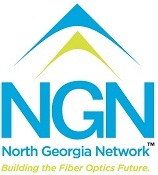 All this to say – NGN recognizes the need to make a compelling case to move from current broadband service to the ultra-fast fiber service NGN is now offering. With this recognition, NGN looked for a partner to help drive adoption and uptake, selecting SNG, our proprietary solutions and unparalled research database to help deliver a compelling business case for businesses and organizations to move to a more robust broadband service.
All this to say – NGN recognizes the need to make a compelling case to move from current broadband service to the ultra-fast fiber service NGN is now offering. With this recognition, NGN looked for a partner to help drive adoption and uptake, selecting SNG, our proprietary solutions and unparalled research database to help deliver a compelling business case for businesses and organizations to move to a more robust broadband service.
Continue Reading →
by John de Ridder
 Last year, we discussed how North Carolina and Tennessee were putting a stop to public broadband investment competing with private investment[i]. Meanwhile at the other extreme, the Australian Government is making a massive public investment in a national fiber access network (the NBN). SNG’s new white paper, EU Guidelines for Public Investment in Broadband, reviews the rules proposed in Europe (EU)[ii] for a more sensible division of roles between private and public investment in broadband.
Last year, we discussed how North Carolina and Tennessee were putting a stop to public broadband investment competing with private investment[i]. Meanwhile at the other extreme, the Australian Government is making a massive public investment in a national fiber access network (the NBN). SNG’s new white paper, EU Guidelines for Public Investment in Broadband, reviews the rules proposed in Europe (EU)[ii] for a more sensible division of roles between private and public investment in broadband.
Continue Reading →
The promise of faster broadband is unlikely to drive consumers to take up new fibre-based services, according to a briefing paper from broadband economists Strategic Networks Group.
SNG has been collecting information about broadband utilisation in a number of regions around the world; it said that once the build phase of ult

ra-fast broadband network initiatives wind down, network operators are finding that businesses, organisations, and individuals are not adopting the services in the numbers they had planned.

The promise of faster broadband is unlikely to drive consumers to take up new fibre-based services, according to a briefing paper from broadband economists Strategic Networks Group.
SNG has been collecting information about broadband utilisation in a number of regions around the world; it said that once the build phase of ultra-fast broadband network initiatives wind down, network operators are finding that businesses, organisations, and individuals are not adopting the services in the numbers they had planned.
They said that one of the main problems is that “faster” is not a benefit, while promising “a new world of possibilities” was too vague to attract demand. “Benefits are what the pragmatist looks for when making a change or adopting a technology. So is it any wonder that “faster,” a feature, is not driving the network uptake desired?” argued the paper’s authors, Doug Adams and Michael Curri.
“Ultra-fast broadband networks are no different than the lifecycle of every technology service product since “high tech” was a wheel. It takes time – time that most networks just cannot afford.”
According to SNG data, users are typically slow to adopt applications such as teleworking, rich media and e-business services. However, it is these types of services that it said were key to the economics of fibre broadband.
“Getting past your network’s reliance on innovators and early adopters and across the chasm requires demonstrating value to the more pragmatic of technology adopters, the early and late majority,” it said.
“Unfortunately, the slow to adopt e-solutions are better served with ultra-fast broadband… so carriers are dealing with two challenges: 1) making the e-solutions relevant; and, 2) driving uptake so that individuals and organisations can realise these benefits.”
Geoff Long
Read the White Paper>> Continue Reading →
In working across the globe and working with multiple carriers deploying new, more robust broadband networks, Strategic Networks Group consistently comes up against the notion that once the network is built, adoption will naturally follow. “Build it and they will come” is a school of thought that expresses the great hope that potential subscribers will naturally adopt, however this notion goes against what we have always known about technology adoption.
Meanwhile, broadband is broadband for many consumers and businesses – who do not see the difference, nor what is possible with ultra-fast broadband (e.g. fiber / Fiber-to-the-Home). On the other hand, organizations like US Ignite are forming to promote “Next generation Applications,” specifically new applications in education, healthcare, clean energy, public safety, and workforce development, including advanced manufacturing. These require the ultra-fast broadband connectivity which the networks being rolled out today will provide. And before we get to “Next generation applications,” consider the bandwidth required to support online collaboration so critical to being competitive in a 21st century economy.
Continue Reading →
(from SNG’s One-of-a-Kind Broadband Utilization Database)
By Thibaud Chatel
Over the last several months, a question that keeps coming up from the economic development folks we work with is this… “What are the most impactful digital innovations to improve businesses productivity?” They’re looking for ways that broadband can have the quickest impacts on the businesses in their region.
Well, based on SNG’s database (the Digital Economy Analytics Platform), which contains facts, not hearsay or hunches, here are some answers…
Continue Reading →
Measuring Broadband’s Impacts and ROI
What Does Broadband Do and Don’t Make Me Think About It
by Doug Adams
It was one of those conversations you can only have at a conference, when you are exhausted after a long day, and your edit buttons are turned off. Michael Curri and I were dining with a community broadband consultant from Georgia who wanted to know, specifically, how to sell SNG’s services, designed to drive utilization and economic advancement, into her communities.
 Now she wasn’t asking because she doesn’t get “it.” She understands the power of utilization and not just the power of availability. She gets what SNG does with regards to helping communities drive said utilization. What she didn’t get after a long day of sessions and networking… is how to make it simple for communities to understand. More specifically, mayors, governors, chambers of commerce, etc.
Now she wasn’t asking because she doesn’t get “it.” She understands the power of utilization and not just the power of availability. She gets what SNG does with regards to helping communities drive said utilization. What she didn’t get after a long day of sessions and networking… is how to make it simple for communities to understand. More specifically, mayors, governors, chambers of commerce, etc.
So I was reminded of a book I read when looking into building “usable” websites called “Don’t Make Me Think.” What does website usability have to do with this situation? Everything. After all, when designing a website – we often design it for ourselves… it makes sense to us, so it must make sense to everyone else.
It is the same with broadband. The benefits of broadband and everything that come with it are typically at our core – it is second nature. We understand the benefits that this platform for innovation provides, both economic and social. But to make it tangible, understandable, usable to most people – including most people in government – let’s answer one question. It’s a business question. What is my ROI?
So how do we make broadband’s benefits tangible? We show a track record of results. By specifically looking at the initiatives we have with Virginia, we’re able to uncover that…
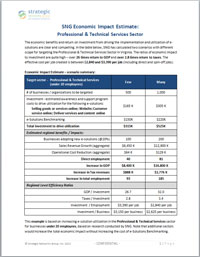 The economic benefits and return on investment from driving the implementation and utilization of e-solutions are clear and compelling. The impacts vary by sector, but to examine just one – Professional and Technical Services (i.e. engineers, architects, consultants) with less than 20 employees. Within this sector, SNG sees the economic development impact of utilization to be over 26 times return to GDP. And so, Mr. Mayor… for every dollar you spend with SNG’s programs to drive utilization, you receive $2.80 in tax revenues times return to taxes. Learn More>>
The economic benefits and return on investment from driving the implementation and utilization of e-solutions are clear and compelling. The impacts vary by sector, but to examine just one – Professional and Technical Services (i.e. engineers, architects, consultants) with less than 20 employees. Within this sector, SNG sees the economic development impact of utilization to be over 26 times return to GDP. And so, Mr. Mayor… for every dollar you spend with SNG’s programs to drive utilization, you receive $2.80 in tax revenues times return to taxes. Learn More>>
Even for one sector and a sizeable investment, the economic impact ratios are very compelling and well worth the investment. The actual numbers will vary, but the economic case for making such investments is clear.
So while there is not “one number,” there is definitely a significant ROI multiplier – drop me an email and we’d be happy to run some scenarios for your community/region.
Consider a New Model
Broadband Program Management… What’s the Best Way?
by Michael Curri
When administering a new program to deploy broadband and stimulate adoption, governments traditionally ramp-up their internal resources or hire consultants.
But there’s an alternative – a model that leverages existing local resources and links with local stakeholders who have a vested interest in the project outcome of economic development through broadband.
The downsides for the traditional models are apparent. Ramping-up internal staff requires hiring and getting everyone up to speed on how to administer the program. And once the program ends, the staff you worked so hard to find and train will leave. Bad enough that you lose good people you’ve invested in, but staff may be looking for a job during their time with you, looking for a better deal to move on to a permanent position. If this happens, you’re left to restart – and you lose ‘history’ before projects have been completed before they take-on their new job.
For governments that use consulting support, the hiring process can be much shorter. But there is still the getting ‘up-to-speed’ time required – and it can be extensive when junior consultants are being used. Although the cost of hiring such ongoing consulting support can be high, there are opportunities to negotiate a better rate with the consulting firm as they are acquiring broadband program administration skills and experience that can be redeployed in other jurisdictions.
A third way – the way we would advocate – involves a model where government delegates certain elements of administration to stakeholders that are local to a local broadband project. Local economic development agencies are prime candidates as they:
- Are aligned with the economic development goals of broadband projects – this could have the ancillary benefit of transforming how economic development agencies approach economic development from traditional ‘smoke stack chasing’ to economic development through broadband
- Have existing local knowledge and relationships that can be leveraged – especially where they can identify and broker new partnerships that are mutually beneficial, increasing the sustainability of the broadband project
- Can be more cost-effective in overseeing projects as they are local and as they already have some administrative capacity – more regular and spot visits are possible because they’re local, plus purchases that don’t align with the needs of the community / region are more likely to be identified right away
This type of model enables the government focus on strategic and key administrative issues, while leveraging an existing network of resources that is aligned with the sustainability of the broadband projects they would administer. And when the government programming sunsets, those local economic development agencies remain as a support system to broadband projects as needed.
Post Conference Thoughts
After spending a few days in both Dallas and Washington DC over the past month, it is apparent that the biggest challenge facing broadband projects in every U.S. region is sustainability, and key to that of course is utilization.
As projects are finishing building their broadband infrastructure, now more than ever is the time for SNG to help meet the challenges of going from build to use.
Unfortunately, we have heard from way too many regions who tell us their adoption rates are low and the networks are not – and will not be – sustainable without major uptake.
Low adoption rates (i.e. 20%) cannot sustain the ongoing operations of a broadband network where the business case requires 40-50% uptake.
As your needs increase to drive uptake, please make sure you reach out to SNG as we have introduced some So they’re now beginning to focus on how to increase adoption rates and they’re realizing that they need to drive utilization with end-users – our focus and strength as we’ve again demonstrated with the new DEi Calculator.
What Does Broadband Do and Don’t Make Me Think About It
by Doug Adams
It was one of those conversations you can only have at a conference, when you are exhausted after a long day, and your edit buttons are turned off. Michael Curri and I were dining with a community broadband consultant from Georgia who wanted to know, specifically, how to sell SNG’s services, designed to drive utilization and economic advancement, into her communities.
 Now she wasn’t asking because she doesn’t get “it.” She understands the power of utilization and not just the power of availability. She gets what SNG does with regards to helping communities drive said utilization. What she didn’t get after a long day of sessions and networking… is how to make it simple for communities to understand. More specifically, mayors, governors, chambers of commerce, etc.
Now she wasn’t asking because she doesn’t get “it.” She understands the power of utilization and not just the power of availability. She gets what SNG does with regards to helping communities drive said utilization. What she didn’t get after a long day of sessions and networking… is how to make it simple for communities to understand. More specifically, mayors, governors, chambers of commerce, etc.
Continue Reading →
Broadband Program Management… What’s the Best Way?
by Michael Curri
When administering a new program to deploy broadband and stimulate adoption, governments traditionally ramp-up their internal resources or hire consultants.
But there’s an alternative – a model that leverages existing local resources and links with local stakeholders who have a vested interest in the project outcome of economic development through broadband.
T  he downsides for the traditional models are apparent. Ramping-up internal staff requires hiring and getting everyone up to speed on how to administer the program. And once the program ends, the staff you worked so hard to find and train will leave. Bad enough that you lose good people you’ve invested in, but staff may be looking for a job during their time with you, looking for a better deal to move on to a permanent position. If this happens, you’re left to restart – and you lose ‘history’ before projects have been completed before they take-on their new job.
he downsides for the traditional models are apparent. Ramping-up internal staff requires hiring and getting everyone up to speed on how to administer the program. And once the program ends, the staff you worked so hard to find and train will leave. Bad enough that you lose good people you’ve invested in, but staff may be looking for a job during their time with you, looking for a better deal to move on to a permanent position. If this happens, you’re left to restart – and you lose ‘history’ before projects have been completed before they take-on their new job.
Continue Reading →
After spending a few days in both Dallas and Washington DC over the past month, it is apparent that the biggest challenge facing broadband projects in every U.S. region is sustainability, and key to that of course is utilization.
As projects are finishing building their broadband infrastructure, now more than ever is the time for SNG to help meet the challenges of going from build to use.
Unfortunately, we have heard from way too many regions who tell us their adoption rates are low and the networks are not – and will not be – sustainable without major uptake.
Low adoption rates (i.e. 20%) cannot sustain the ongoing operations of a broadband network where the business case requires 40-50% uptake.
As your needs increase to drive uptake, please make sure you reach out to SNG as we have introduced some So they’re now beginning to focus on how to increase adoption rates and they’re realizing that they need to drive utilization with end-users – our focus and strength as we’ve again demonstrated with the new DEi Calculator.
Big Hats, Big Questions, and Big Broadband
The Question “What’s Next?” Dominates Broadband Summit
by Doug Adams
This year’s preeminent question for most attendees at the Broadband Summit in Dallas seemed to be “What’s Next?”
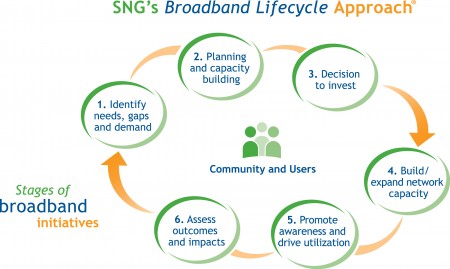 With builds nearing completion, many American States are in the throes of step 4 of the broadband lifecycle, left to wonder… what do we do now? How do we drive adoption? And at SNG we’d add…how do we turn adoption into utilization?
With builds nearing completion, many American States are in the throes of step 4 of the broadband lifecycle, left to wonder… what do we do now? How do we drive adoption? And at SNG we’d add…how do we turn adoption into utilization?
So along the lifecycle, many regions in the U.S. have gotten the “supply side” of broadband down (building the network).
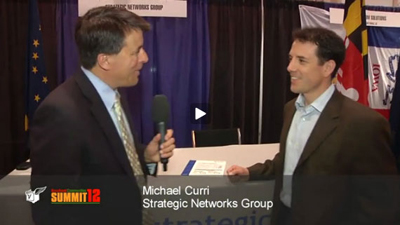
In an interview on the conference floor, Michael Curri explains the importance of the "demand side" of broadband... and how SNG can help.
SNG Unveils DEi Calculator in Dallas
What’s Your Broadband IQ?
We were thrilled to receive rave reviews with the introduction of our DEi Calculator in Dallas.
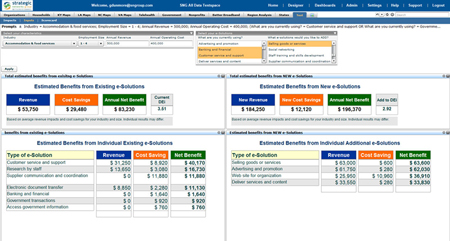 Businesses, organizations, and individuals can use the DEi calculator as a companion to the Digital Economy index (DEi) Scorecard, both designed to help them understand how to embrace new technologies and business practices, and leverage e-solutions to grow and enhance their opportunties.
Businesses, organizations, and individuals can use the DEi calculator as a companion to the Digital Economy index (DEi) Scorecard, both designed to help them understand how to embrace new technologies and business practices, and leverage e-solutions to grow and enhance their opportunties.
SNG’s Digital Economy index (DEi) Scorecard and online DEi Impact Calculator gives end-users the power and insights of years of SNG’s broadband research. Users can quickly identify ways to be more effective, productive, and competitive by leveraging broadband by comparing themselves against tens of thousands of their peers in SNG’s database.
The DEi Scorecard and DEi Impact Calculator are an excellent solution to help drive utilization of e-solutions, of utmost interest to:
- Carriers looking for new subscribers or current subscribers to upgrade to fiber
- Economic development agencies looking to give their constituents a roadmap to maintain and grow their business using broadband
- Broadband project managers looking to drive uptake and use of their ultra-fast broadband network
Regions and economic development agencies are excited about the possibility of putting this tool in the hands of their constituents, helping them understand… How does a local business compare to the competition? What are other organizations doing better to leverage broadband? What are the benefits of broadband that individuals should be leveraging? Learn More>>
(Almost) Live From Dallas
Once again, Jim Baller and broadbandus.tv did great work broadcasting many sessions from the Broadband Summit. If you haven’t already, we would encourage you to visit the site… it does require a one-time registration. Michael Curri moderated a jam-pack 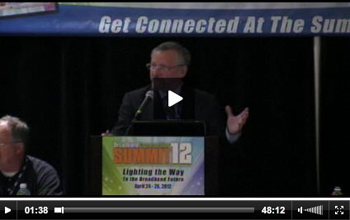 ed session examining the challenges of transitioning from build mode to utilization.
ed session examining the challenges of transitioning from build mode to utilization.
Winning Strategies for the Emerging Knowledge Economy included panelists Bruce Abraham (North Georgia Network), Donny Smith (Jaguar Communications), Kyle Hollifield (Bristol Virginia Utilities), and Betty Zeman (Cedar Falls Utilities).
For a copy of the PowerPoint from this session, click here.
What’s Next… Industry Luminary Insights
Larry Strickling, NTIA
The Honorable Lawrence E. Strickling, Assistant Secretary of Commerce, Administrator, National Telecommunications and Information Administration (NTIA) gave the keynote address at the Broadband Summit, he summed up the U.S. governments “what’s next” in 5 steps…
1) Remain dedicated to make sure grantees complete projects on time and on budget.
2) Finding opportunities to expand projects where build savings can be leveraged.
3) Conduct a multi-year evaluation program in place to measure ROI and inform future decisions
4) Use the recently passed legislation to enact a national public safety broadband network to help reach even more rural areas with broadband
5) Upon completion of grants, deploy the NTIA team to drive access in America.
James Salter, AEG
Chairman of Atlantic Engineering Group (AEG), James Salter was extremely entertaining as he looked both backward and forward.
Salter had both praise and criticism for the stimulus program. Kudos for recognizing that rural broadband is “basic infrastructure” and concern for the amount of time it has taken to get things approved and moving – a natural problem given the resources available to administer this massive task.
So the question he examined was – now what… when it comes to rural broadband?
Salter compares the need for further government involvement and investment, much like we saw in the 1930’s, driving electricity to homes everywhere.
And he sees the capacity to fund only one network in rural America – it does not matter who does it. His argument was that it is not profitable or possible to have more than one carrier survive in a competitive environment. The pure math is that there is not a big enough pie for carriers to be fighting over customers – and whatever network provides “triple play” services (TV, broadband and phone) also needs to be robust enough to serve all of the community’s broadband needs.
 All this to say – NGN recognizes the need to make a compelling case to move from current broadband service to the ultra-fast fiber service NGN is now offering. With this recognition, NGN looked for a partner to help drive adoption and uptake, selecting SNG, our proprietary solutions and unparalled research database to help deliver a compelling business case for businesses and organizations to move to a more robust broadband service.
All this to say – NGN recognizes the need to make a compelling case to move from current broadband service to the ultra-fast fiber service NGN is now offering. With this recognition, NGN looked for a partner to help drive adoption and uptake, selecting SNG, our proprietary solutions and unparalled research database to help deliver a compelling business case for businesses and organizations to move to a more robust broadband service.
 Last year, we discussed how North Carolina and Tennessee were putting a stop to public broadband investment competing with private investment
Last year, we discussed how North Carolina and Tennessee were putting a stop to public broadband investment competing with private investment
 Now she wasn’t asking because she doesn’t get “it.” She understands the power of utilization and not just the power of availability. She gets what SNG does with regards to helping communities drive said utilization. What she didn’t get after a long day of sessions and networking… is how to make it simple for communities to understand. More specifically, mayors, governors, chambers of commerce, etc.
Now she wasn’t asking because she doesn’t get “it.” She understands the power of utilization and not just the power of availability. She gets what SNG does with regards to helping communities drive said utilization. What she didn’t get after a long day of sessions and networking… is how to make it simple for communities to understand. More specifically, mayors, governors, chambers of commerce, etc.
 he downsides for the traditional models are apparent. Ramping-up internal staff requires hiring and getting everyone up to speed on how to administer the program. And once the program ends, the staff you worked so hard to find and train will leave. Bad enough that you lose good people you’ve invested in, but staff may be looking for a job during their time with you, looking for a better deal to move on to a permanent position. If this happens, you’re left to restart – and you lose ‘history’ before projects have been completed before they take-on their new job.
he downsides for the traditional models are apparent. Ramping-up internal staff requires hiring and getting everyone up to speed on how to administer the program. And once the program ends, the staff you worked so hard to find and train will leave. Bad enough that you lose good people you’ve invested in, but staff may be looking for a job during their time with you, looking for a better deal to move on to a permanent position. If this happens, you’re left to restart – and you lose ‘history’ before projects have been completed before they take-on their new job. With builds nearing completion, many American States are in the throes of step 4 of the broadband lifecycle, left to wonder… what do we do now? How do we drive adoption? And at SNG we’d add…how do we turn adoption into utilization?
With builds nearing completion, many American States are in the throes of step 4 of the broadband lifecycle, left to wonder… what do we do now? How do we drive adoption? And at SNG we’d add…how do we turn adoption into utilization?




